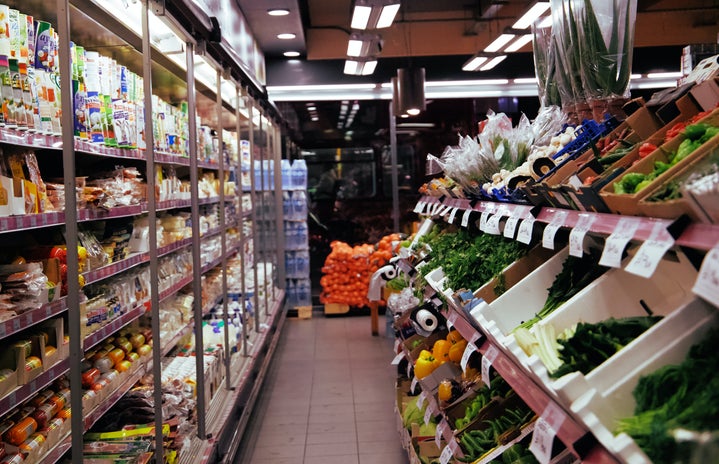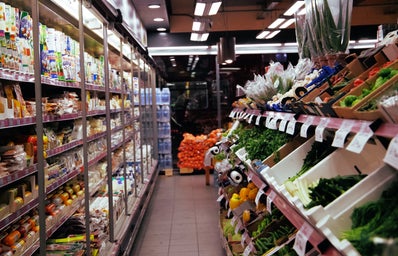As a college student, grocery shopping is quite the daunting task. Whether you’re buying for microwave meals in a dorm or stocking up for an off-campus house, a successful grocery shopping trip always takes a few tries to achieve. Luckily for you, we have already mastered the tips and tricks needed to accomplish an easy, inexpensive grocery haul and we are happy to share. For the sake of this article, I will let you in on my experience buying groceries for my off-campus house about $50-$60 every two weeks.
Our number one tip when it comes to grocery shopping is to plan! You know when you go to Target for one thing and then walk out with three bags? That’s exactly what we’re trying to avoid. So the first step is to make a list and stick to it like your life depends on it. When it comes to thinking of items to put on your list, try your best to be versatile. While it’s great to try a complex recipe every now and then, sometimes buying ingredients for just one recipe will eat up your budget. By choosing versatile ingredients that can be combined in various ways, you will get more for your buck without getting tired of your meal choices.

Starting off the full grocery guide is proteins. We suggest getting two solid choices for protein. For those who eat meat this may include chicken breasts, ground beef, burgers or even deli meat if you love sandwiches. Beyond the meat category, there are other great protein sources such as fish, seafood, tofu or tempeh. It’s important to remember that these protein choices will most likely be the center of your dish, so make sure you get ingredients you’ll be happy eating more than once throughout the week. As you’ll come to find, this guide is set in categories to include the numerous food lifestyles people may follow, so feel free to get creative with your choices!
Next up is carbs. Since most typical carb ingredients are pretty affordable, you’re safe to choose two to three options depending on what you’re feeling. This category includes pasta, rice, potatoes or really any “side dish” you can think of except bread. We will get to bread later. Because ingredients in this category are so simple to begin with, it’s easy to prepare them in different ways to keep you excited for meals.
Let’s get into the greens! Pro tip: always go for frozen vegetables. Yes, fresh is generally better but frozen lasts much longer, making it an essential staple when trying to stretch your groceries. Think about any vegetable you wouldn’t mind throwing on your plate as a nutritious side, you don’t need to plan around the vegetables. This category might be dread for picky eaters but we encourage everyone to branch out and find their favorites. It’s pretty easy to find most vegetables in the frozen aisle but if you’re struggling, broccoli, green beans, peas and carrots are among the most common frozen veggies.

For the other side of produce we have fruits. If you’re starting to catch onto the pattern this won’t be a surprise. Plan to get two types of fruit! We recommend fruits that have some staying power, fruits like apples, mangoes, or melon that won’t go bad in a few days. Any fruit you like you can make work but just be aware of how fast it goes bad and ensure it won’t go to waste!
Now that we’ve covered the major categories, full meals are pretty much laid out. But we get it, sometimes cooking is too much work or you just can’t consume one more piece of chicken for the life of you. That is why this category is “fun frozen items.” Fun frozen items can range from frozen pizza, chicken nuggets or a frozen pre-made meal (Trader Joe’s has great frozen meals). Again, this category isn’t an essential but we find that it keeps things interesting from meal to meal. Think of this category as something you can have as a meal or as part of a meal, desserts like ice cream will follow in a different category.
To finish the guide off we have a few basics that didn’t fit into a specific category. Items like bread, eggs, and the milk of your choice stand as foundational ingredients that everyone should include in their list. From there, you can branch out with ingredients that go along with those basics. For example, cereal to go with milk or anything you like to put on your toast like jelly or avocado. Don’t forget to also include items you may need to compliment your meal choices like marinara sauce for pasta or buns for burgers. It’s all up to your taste.
Last but not least we have snacks and sweets! This category is not always a necessity but we encourage you to treat yourself with your favorite snacks throughout the week. Snacks and sweets can include anything from chips and crackers to ice cream and cookies.
Just like that you are set for solid meals for about two weeks! The more you go grocery shopping the more you’ll build a sense of what you need/want as well as things that you’ll just have that you don’t need to buy every time. Items such as spices, canned beans or different frozen things that last a while act as something to stock up on when you can so that you don’t have to buy them consistently. Grocery shopping is a learning process and this guide will help get you started on the path of budgeted success. Good luck and happy shopping!



